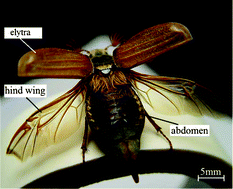Structure and mechanical properties of beetle wings: a review
Abstract
Insects of extremely small size have evolved to solve many problems. Their structure and mechanical properties information can be utilized to mimic them for industrial applications. Since beetle (Coleoptera, an order of insects) wings exhibit special functionalities, they have sparked worldwide research attention. Beetle wings are composed of a forewing (also known as elytron) and a hind wing. The elytra are rigid. A beetle's functional wings, which allow flying, are the hind wings. The elytra have an ingenious structure with superhydrophobic characteristics, a structural coloration and anti-adhesion characteristics. Their inner structure helps to provide light mass and high strength. The rotation angle and wing locking system of elytra are important features which increase beetles’ ability to fly; they may furnish an insight for portable micro air vehicles (MAVs) and also provide inspiration for the design of bioinspired deployable systems. Studies of the structural and mechanical properties in biological systems may improve the understanding of natural solutions and advance the design of novel artificial materials. In this paper, the structure, mechanical properties and their relationship to function of beetle wings are discussed. Examples of bioinspired structures and materials are also presented.


 Please wait while we load your content...
Please wait while we load your content...